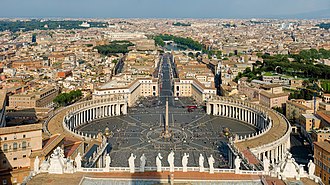European microstates
The European microstates are a handful of very small states on the continent of Europe or its islands. Properly speaking, microstates are internationally recognised, but this term may be confused with "micronations" and other small entities. How small they have to be is subjective, but a rough definition might be "smaller than Luxembourg", which is 82 km north-south, 57 km east-West, and has a population of around 660,000.
Microstates
[edit]
These are very small states but internationally recognised as fully independent. They may cede some functions such as defence to a larger neighbour, and have an open border with it.
- Andorra — small mountainous country between France and Spain
- Liechtenstein — German-speaking country between Switzerland and Austria
- Malta — island in the Mediterranean between Italy and Tunisia
- Monaco — surrounded by the French Riviera
- San Marino — surrounded by Italy
- Vatican City — surrounded by the city of Rome
Dependencies
[edit]These are territories with local autonomy, but under the patronage of a larger state, which may control defence, currency and so on. This does not include areas that are duty-free but otherwise part of a nation, such as Samnaun in Switzerland (border with Austria) or Livigno in Italy (border with Switzerland), or any airport duty-free shop. It also excludes "extraterratoriality" such as US airbases in Europe, embassies, and the Norwegian oil and gas facility in England.

- Akrotiri and Dhekelia (United Kingdom) — British military bases on the island of Cyprus
- Åland (Finland) — a Swedish-speaking archipelago in the Baltic Sea
- Faroe Islands (Denmark) — self governing archipelago between the United Kingdom and Iceland
- Gibraltar (United Kingdom) — a British peninsula off mainland Spain
- Guernsey (United Kingdom) — an island in the English Channel that also governs Herm, Sark and Alderney.
- Heligoland (Germany) — a car-free and duty-free island in the North Sea
- Isle of Man (United Kingdom) — a large island between England and Ireland
- Jan Mayen (Norway) — in the Arctic Ocean, featuring the Earth's northernmost active volcano
- Jersey (United Kingdom) — the largest of the Channel Islands, off the coast of France
- Mount Athos (Greece) — an autonomous state under Greek sovereignty, home to Eastern Orthodox monks
- Svalbard (Norway) — an archipelago halfway between Norway's North Cape and the North Pole
Exclaves
[edit]
All the coastal countries of Europe have populated islands that may have some local autonomy, but that are governed in the same way as the mainland provinces. The many examples include Sicily, Crete, the Azores of Portugal, the Canary and Balearic islands of Spain, and the Hebrides of Scotland. Less common are exclaves or "land islands" - tracts of territory separated from the main body of their nation. They may have varied border and duty-free arrangements, nevertheless they are fully part of that nation.
- Büsingen am Hochrhein — a German exclave in Switzerland
- Campione d'Italia — an Italian exclave in Switzerland
- Kaliningrad — a Russian exclave between Lithuania and Poland.
- Llívia — a Spanish exclave in the French Pyrenees.
- Nakhchivan — a region of Azerbaijan separated from it by Armenia.
- Baarle — Belgian exclaves in the Netherlands that in turn surround Dutch counter-enclaves.
These are sometimes called enclaves but that term is only correct if they're fully surrounded by a single nation, such as Llívia within France.
Disputed territories
[edit]
These entities wish to be recognised as sovereign states, but are so to varying degree - often it's only their sponsoring nation that does so. Travellers have to accept the de facto control of their authorities and most can be entered on those terms. Problems arise if you then try to exit through a different country, which may accuse you of illegally entering through what they maintain is their wrongfully-occupied territory.
- Abkhazia (Georgia) — a Russian-backed breakaway republic in the Caucasus
- Kosovo — formerly part of Serbia, which is now one of the few standouts against this widely-recognised republic
- Northern Cyprus (Cyprus) — Turkish-backed republic on the island of Cyprus. It's not part of the EU, but the border with Greek-speaking Cyprus is easy to cross.
- South Ossetia (Georgia) — a Russian-backed breakaway republic in the Caucasus, culturally connected to the Russian republic of North Ossetia
- Transnistria (Moldova) — an independent republic on the banks of the Dniester River, backed by Russia
Condominiums are where countries share sovereignty, all nice and amicable until there's a falling out and the place becomes disputed. Brčko is a condominium between Bosnia-Herzegovina and Republika Srpska. One that has lasted since 1659 is the uninhabited Île des Faisans, a river island near Hendaye. Twice a year it changes hands between France and Spain, whereupon it becomes Isla de los Faisanes, or Faisai Uhartea in Basque, with no dispute at all.


 Français
Français Italiano
Italiano



